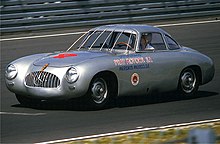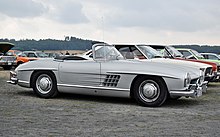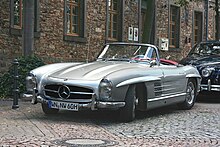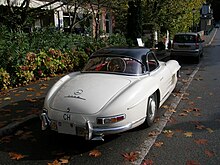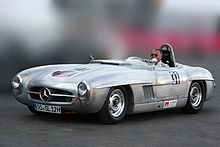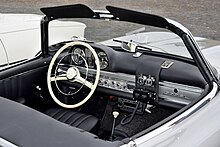Mercedes-Benz W 198
| Mercedes Benz | |
|---|---|
|
Mercedes-Benz 300 SL Coupé (1955)
|
|
| W 198 | |
| Sales designation: | Mercedes 300 SL |
| Production period: | 1954-1963 |
| Class : | Sports car |
| Body versions : | Coupé , roadster |
| Engines: |
Otto engines : 3.0 liters (158 kW) |
| Length: | 4520-4570 mm |
| Width: | 1790 mm |
| Height: | 1300 mm |
| Wheelbase : | 2400 mm |
| Empty weight : | 1295 kg |
The Mercedes-Benz W 198 is a sports car of the Mercedes-Benz brand , which Daimler-Benz AG produced from 1954 to 1963. Under the sales name Mercedes-Benz 300 SL , it was offered as a coupé with gull-wing doors from 1954 to 1957 and as a roadster ( W 198 II ) from 1957 to 1963 ; 1400 coupes and 1858 roadsters were built.
Mercedes-Benz presented the 300 SL in February 1954 at the International Motor Sports Show in New York . It was the fastest sports car of its time. In 1999 the vehicle was voted "Sports Car of the Century" by readers of the German classic car magazine Motor Klassik .
The number 300 in the sales designation stands for the cubic capacity measured in centiliters , the additional designation SL is short for "super-light".
Vehicle history
Previous version W 194 in motorsport
The W 198 goes back to the racing sports car Mercedes-Benz W 194 , which was already named "300 SL". He achieved unexpected racing success in 1952. In the previous year, Daimler-Benz had made the decision to take part in races again in 1952 and to build a sports car for them. In order to achieve sufficient power for races, the existing engine of the Coupé 300 S (M 188) had to be further developed. Still equipped with carburettors, it developed 175 hp (129 kW).
In 1952 the vehicle took part in the most important races of the year, against opponents with significantly more powerful engines. For the first time, the new SL showed speed and reliability at the Mille Miglia at the beginning of May and achieved second place in this endurance race. The triple victory was achieved at the Bern Prize . The racing car unexpectedly ended the Le Mans 24-hour race with a one-two finish. The winners were Hermann Lang and Fritz Riess . With an overall average of 155.575 km / h, they set a new record in Le Mans history. Second were Theo Helfrich and Helmut Niedermayr . A race at the Nürburgring ended with a quadruple success. At the Carrera Panamericana in Mexico , the 300 SL with Karl Kling and Hans Klenk won again - despite a vulture that had flown through the windshield. In this way, Mercedes-Benz built on the great successes in racing before the Second World War .
A special vehicle in SL history was the 300 SL with chassis number 0011/52, which was developed for the 1953 racing season. But the car was not used because Mercedes-Benz decided to take part in Formula 1 again from 1954. This made the “planer”, as the vehicle was also called by the test engineers because of its striking front section, as an intermediate model for the 300 SL (W 198 I) series sports car presented in 1954. The one-off, which has been in the factory since 1952 and is now in the care of Mercedes-Benz Classic, already had the engine with direct petrol injection and 16-inch wheels. Its gearbox was built into the rear axle . The body was redesigned in favor of lower air resistance. However, the arrangement of the gearbox was not adopted in series production.
The production vehicle
Series production of the 300 SL was not initially planned. But Max Hoffman , US importer of Mercedes-Benz vehicles, had been asking the Daimler-Benz board of management for a large and a small Mercedes sports car for its customers for some time. A basis for this could be the racing coupé from 1952, which surprisingly won the Carrera Panamericana and was therefore well known in the USA. After much deliberation, the decision was made to start series production of the 300 SL in the street version as the W 198. In addition, the production of a smaller roadster , the Mercedes-Benz W 121 B II (190 SL), was announced.
Less than six months after the board resolution, the two sports cars premiered at the “International Motor Sports Show” in New York, which took place from February 6-14, 1954. At the Motor Show, Mercedes-Benz experienced extremely positive visitor feedback on the 300 SL and 190 SL. Series production began in August 1954 at the Sindelfingen plant . Compared to the 300 SL on display in the USA, there were small changes for the series, namely triangular windows in the doors, changed door locks, a two-spoke steering wheel instead of the three-spoke steering wheel with spring spokes, a timer and a few control buttons on the dashboard were repositioned. There were also operating levers for heating and ventilation that the exhibition model did not yet have. Shortly after the start of production or from the 51st car, the long gear lever, which intervened directly in the transmission, was replaced by a shorter one with a gear lever. The first W 198 were initially sold in Europe in 1954 and the first vehicle was exported to the USA in March 1955. Of the total of 1,400 gullwing models built, the majority, around 1,100, ended up in the USA. The 300 SL Roadster (W 198 II) was built from 1957 to meet the special requirements of customers in the USA (a little more comfort, larger trunk and often a convertible ). There were 1858 pieces of this model.
The price of the W 198 was set at 29,000 German marks . In 1953 a Mercedes 170 Vb cost 7900 DM. In 1954, the 300 SL was not the most expensive car in the Mercedes range - the W 188 cost 5500 DM more (with lower mileage). The purchase price of a VW Beetle Standard in 1953 was 4400 DM; Two years later, this roughly corresponded to the average annual gross income of an industrial worker with a weekly working time of 48 hours.
Sport easy or super easy ?
An official long form for the abbreviation “SL” was not announced by Mercedes-Benz. It is often assumed that the letters stand for “Sport Leicht”. The magazine auto, motor und sport reported in 2012, however, without giving any sources, that the abbreviation “SL” - “certified and personally signed by Rudolf Uhlenhaut ” - means nothing else than “super light”. This statement contradicts the work “Mercedes-Benz 300 SL” by Engelen / Riedner / Seufert, which was created in close cooperation with Uhlenhaut, and which specifies the long form with “Sport Leicht”.
Mercedes-Benz used both long forms until 2017: In the “Mercedes-Benz Classic” magazine published by the Classic division, it was also given Super Light . In contrast, on the website of the same group division it was called Sport Leicht until 2017 and was changed to "Super-Leicht" after an archive discovery.
For a long time it remained unclear what Daimler-Benz intended at the time when assigning the letter combination. It was not until the beginning of 2017 that a press release from 1952 found by chance in the corporate archive clarified beyond any doubt that the abbreviation SL stands for super-light .
Race and rally successes
At the 1955 Mille Miglia , Fitch / Gendebien won a class victory with the series SL, alongside the victory of Stirling Moss in the 300 SLR racing sports car . Werner Engel was European Touring Car Champion in 1955 with the 300 SL, and Walter Schock in 1956 . The Liège – Rome – Liège marathon rally was won in 1955 by Olivier Gendebien and in 1956 by Willy Mairesse . In the USA, Paul O'Shea became champion in the Class D racing category of the Sports Car Club of America's sports car championship in front of Carroll Shelby on a Maserati in 1957 with the roadster that the racing department in Stuttgart built for use in the USA . A use in the Production Class was not yet possible in 1957 because of the series production that had just started. The two roadsters used by Paul O'Shea were called the 300 SLS.
technical description
The W 198 is a two-door sports car that was built as both a coupé and a roadster. It has a tubular space frame with an attached (not self-supporting) body. The engine is installed lengthways at the front and drives the rear wheels. The technology is based in part on the sedan W 186 II (type 300). The top speed of the W 198 is up to 260 km / h , depending on the rear axle ratio . Contemporary car testers determined the consumption with an average of 15 liters of petrol. A 100-liter tank was housed in the rear; a 130-liter version was also available for an additional charge (Roadster only with a 100-liter tank).
Frame and chassis
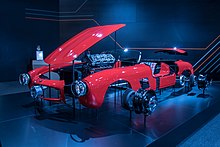
As is common in contemporary racing cars, the W 198 has a tubular space frame designed by Rudolf Uhlenhaut. Such a construction ensures high stability with a low vehicle mass. Thin tubes were put together to form many triangles, the finished frame is very light at 82 kg; except for the front and rear cross members, its elements are only subjected to compression and tension. The entire ready-to-drive car including the spare wheel, tools and fuel weighs 1295 kg, the center of gravity is almost exactly in the center of the vehicle.
The chassis is essentially the same as that of the 300 sedan , but has been made sportier. The front wheels are suspended from double wishbones of unequal length with coil springs and hydraulic telescopic shock absorbers, and a torsion bar stabilizer is also installed. The rear axle is a single-joint swing axle ; it is also cushioned with coil springs and has a hydraulic telescopic shock absorber per wheel. Sheet steel disc wheels measuring 5K × 15 inches are standard , they were also available with a rudge rim 5J × 15 inches and with an offset of half an inch (5½K × 15 inches). The tires have the size 6.50-15 inch Supersport, this corresponds to today's tire size 185 VR15.
The 300 SL Coupé had drum brakes with cooling fins, 26 centimeters in diameter. To reduce the pedal force , a brake booster was used for the first time in passenger car construction , known at the time as " Ate brake shelf", which works with the aid of the vacuum in the intake manifold. The drum brakes on the front wheels have two ten centimeters wide running brake shoes ( duplex brake ) and two wheel brake cylinders. The handbrake is a mechanical parking brake that acts on the rear wheels. The steering gear is a recirculating ball bearing.
body
The body of the 300 SL is largely made of sheet steel, but the bonnet, trunk lid, sill and door skin are made of aluminum . Upon request and for a relatively small surcharge, the entire body was made of light metal, making the vehicle 80 kilograms lighter. But only 29 SL customers chose this version; today these specimens are in great demand. For the body, silver gray was the standard color. Other colors were available upon request.
The aim of the body design was to make the vehicle as aerodynamically efficient as possible. To keep the frontal area small, the body was slightly indented from the window line. Only after the construction of the frame, which reached far up, did it become apparent that conventional doors could not be used on the vehicle flanks because of this frame construction. The eye-catching gull-wing doors were necessary because of the vehicle design. In the English-speaking world, the W 198 was given the nickname "Gullwing" (seagull wing) because of its doors. A discreet rod could be swiveled out of the body to open the doors, unlocked the lock and let the door, supported by two telescopic springs, swing upwards.
Engine and drive train
The car has a six-cylinder in - line engine ( Otto engine ) of the type M 198 with 2996 cm³ displacement, which is technically based on the Mercedes-Benz M 186 . Instead of the two carburettors of the M 186, the M 198 has direct gasoline injection , which was not previously available in four-stroke passenger car engines, and dry sump lubrication to ensure lubrication when cornering quickly and to save the height of the oil pan. The output is 215 PS (158 kW ). So that the engine could be installed in the flat car, it was inclined 45 degrees to the left (also a novelty in series production) - according to other information, however, the "inclined position of the engine is ... 50 ° to the vertical". This reduced the passenger's footwell a little. From March 1962 a revised engine (M 198 III) with a light metal cylinder block was installed; 209 copies of this engine were made.
The power is transmitted from the engine to the gearbox input shaft via a dry single-disc clutch . The car has a four-speed gearbox; five different rear axle ratios were available. The serial ratio at the beginning of the construction period was 1: 3.42; from the 41st vehicle onwards, it was changed to 1: 3.64 in favor of better acceleration. It enables a top speed of 235 km / h; Acceleration from 0 to 100 km / h in 9.3 seconds. The ratios 1: 3.89 and 1: 4.11 offer even better acceleration. The highest speed of 260 km / h is achieved with 1: 3.25. First gear is also relatively long, so that the car is difficult to drive in city traffic.
inner space
The interior of the 300 SL Coupé is not luxurious. Fabric in four checkered patterns was offered as standard for the seat cover. The combinations of the basic colors were red / green, gray / green, gray / blue and gray / red. A red and an offset yellow grid pattern are woven into all checked fabrics. Most customers, however, opted for leather upholstery, which later became standard equipment on the roadster.
To make it easier to get in, the lower part of the steering wheel hub on the coupé can be folded forward 90 ° towards the dashboard, so that the upper part protrudes into the passenger compartment. The tachometer is on the left and the speedometer on the right in the instrument panel. Oil and water thermometers, as well as oil pressure gauges and fuel gauges are arranged under these instruments. The clock sits slightly to the right in the middle of the dashboard. The interior mirror is mounted on the dashboard. The 300 SL did not initially have a standard exterior mirror.
The gullwing has stowage space for luggage behind the driver and front passenger seats, as the space under the tailgate is largely filled by the spare wheel and vehicle tank including the filler neck. However, if luggage is carried in the space behind the seats, the rearview mirror can hardly be used. The interior of the gullwing gets very hot in summer and cannot be adequately cooled by the vehicle's ventilation. The side windows are not retractable, but there are forward triangular vent windows .
Changes to the Roadster (W 198 II)
At 1420 kg, the mass of the roadster is 125 kg greater than that of the coupé, but with an unchanged 215 hp (158 kW), the roadster was also considered to be well-powered. The tubular space frame is also the load-bearing structure of the Roadster, but has been significantly changed in the area of the doors and the rear. This freed up space for a (albeit modest) trunk and hinged doors with much more convenient entry. The rear axle became a single-joint swing axle with a compensating spring , resulting in improved driving characteristics and increased comfort. In March 1961, the wind-cooled drum duplex brakes were replaced by modern disc brakes .
The convertible top of the W-198 Roadster can be stowed under a flap behind the seats and is easy to operate in just a few simple steps. Its external appearance is characterized at the front by the headlights and indicators embedded under a shared cover glass. As with the Coupé, another stylistic feature is the large air outlet in the front side panels. From autumn 1958, Mercedes-Benz delivered an elegant, easy-to-attach hardtop for winter sports fans. It was so popular that a short time later it was one of the most frequently ordered options.
Buyer of the vehicle
Because of its high price, only a few people could buy a Mercedes W 198. Well-known new car buyers for the 300 SL included Stavros Niarchos , Mohammad Reza Schah Pahlavi , Rob Walker , Juan Manuel Fangio , Herbert von Karajan , Tony Curtis , Henri Nannen , Sophia Loren , Romy Schneider , Clark Gable , Gunter Sachs and Glenn Ford - but also Adam Opel AG .
Technical specifications
General data
| Parameters | W 198 (Coupé) | W 198 II (Roadster) |
|---|---|---|
| Years of construction | 1954-1957 | 1957-1963 |
| Dimensions and weights | ||
| wheelbase | 2400 mm | |
| length | 4520 mm | 4570 mm |
| width | 1790 mm | |
| height | 1300 mm | |
| Turning circle | 11.5 m (2 turns of the steering wheel from lock to lock) | |
| Dimensions | 1295 kg | 1420 kg |
| Maximum permissible total mass | 1515 kg | 1560 kg |
| Drag coefficient | 0.425 | 0.537 (open) |
| Top speed | Depending on the gear ratio between 208 and 260 km / h | Depending on the gear ratio between 220 and 260 km / h |
| Acceleration (0-100 km / h) | With standard rear axle ratio 9.3 s | |
| Volume of the fuel tank | 100 l (130 l for an extra charge) | 100 l (of which 9 l reserve) |
| Fuel consumption (DIN 70030) | 9.5 l / 100 km | |
| engine | ||
| Type | Mercedes-Benz M 198 petrol engine | |
| design type | In -line six-cylinder engine , installed lengthways at an angle of 45 ° | |
| cooling | Liquid cooling (15.5 l coolant ) | |
| Engine lubrication | Dry sump lubrication with main flow oil filter and oil cooler (oil content 15 liters) | |
| Mixture preparation | Direct injection with mechanically controlled six-piston injection pump , injection pressure 4.5 MPa | |
| Bore × stroke | 85 × 88 mm | |
| Displacement | 2996 cc | |
| Nominal power (DIN 70020) | 215 hp (158 kW) at 5800 min -1 | 215 hp (158 kW) at 5800 min -1 an additional charge: 240 hp (176.5 kW) at 6000 min -1 with modified camshaft |
| Maximum torque (DIN 70020) | 28 kpm (274.6 Nm) at 4600 min -1 | |
| Compression ratio | 8.55: 1 | |
| Valve control |
OHC : two valves per cylinder, operated by a camshaft via rocker arms , driven by a duplex roller chain |
|
| Power transmission | ||
| drive | Rear wheels | |
| coupling | Single-disc dry clutch | |
| transmission | 4-speed manual transmission , fully synchronized; Translations: I. 3.34, II. 1.97, III. 1.39, IV.1.00, R 2.73 |
|
| Gear ratio of the rear axle drive | optionally 3.64: 1, 3.25: 1, 3.42: 1, 3.89: 1 or 4.11: 1 | |
Test values for acceleration and top speed from relevant automobile magazines
The information on mileage differs in the sources, in some cases considerably.
| Driving performance of the Mercedes-Benz W198 | |||
|---|---|---|---|
| test |
auto motor und sport 21/1955 |
Automobile Revue January 22, 1959 |
auto motor und sport 23/2015 |
| Standard rear axle ratio 130 liter tank |
100 liter tank two people |
60-year-old car, 130 liter tank as standard |
|
| 0-40 km / h | 1.9 s | ||
| 0-50 km / h | 2.8 s | ||
| 0-60 km / h | 4.5 s | ||
| 0-80 km / h | 7.0 s | 5.7 s | 5.1 s |
| 0-100 km / h | 9.3 s | 7.9 s | 7.2 s |
| 0-120 km / h | 12.3 s | 10.2 s | 10.1 s |
| 0-130 km / h | 11.7 s | ||
| 0-140 km / h | 14.1 s | 14.1 s | 13.6 s |
| 0-160 km / h | 17.7 s | 17.0 s | 18.4 s |
| 0-180 km / h | 22.3 s | 24.9 s | |
| 0-200 km / h | 43.8 s | 34.8 s | |
| 400 m with a standing start | 15.3 s top speed 148 km / h |
||
| Top speed | 228 km / h | 237 km / h | 235 km / h |
Replicas
The Mercedes-Benz 300 SL was again and again popular with manufacturers of replicas. Mercedes-Benz had the faithful replica of the 300 SL forbidden by a court because the shape of the vehicle is protected. For example, there were the Mercedes 300 SL Gullwing and Mercedes 300 SL Roadster models from the Bavarian automobile manufacturer Scheib from Germany . Scheib initially built his two models on their own chassis frames. The drive train and chassis, on the other hand, were taken over from the Mercedes-Benz W 124 . The replicas Gullwing and Gullwing Roadster were made in Switzerland. They have a composite body built on a tubular space frame, which is made up of an aluminum layer, epoxy resin and glass fibers. There was a choice of two different six-cylinder engines : the Mercedes-Benz M 103 with an output of 132 kW (180 hp) and the Mercedes-Benz M 104 with an output of 165 kW (225 hp).
In the USA , a gullwing replica is being assembled by M-Wing Motors for the local market under the name Turnkey Gullwing .
In 2012, Daimler had a replica of the W 198 destroyed in public after the Stuttgart Regional Court had granted Daimler copyright protection .
literature
- Eric Le Moine: Mercedes Benz 300 SL Coupé / Gullwing Register # 198.040 & # 198.043
- Markus Bolsinger, Jürgen Lewandowski, Harry Niemann: 50 years of the Mercedes-Benz 300 SL . Delius Klasing Verlag, Bielefeld 2004, ISBN 3-7688-1512-9 .
- Jürgen Lewandowski: Mercedes 300 SL . Südwest Verlag, Munich 1988, ISBN 3-517-01101-0 .
- Günter Engelen, Michael Riedner, Hans-Dieter Seufert: Mercedes-Benz 300 SL. From racing to legend . Motorbuch Verlag, Stuttgart 1999, ISBN 3-613-01268-5 .
- JA Hofelich: Mercedes 300 SL. The dream car from Stuttgart. (= Auto-Classic 5 ). Podzun-Pallas Verlag, Friedberg 1992, ISBN 3-7909-0152-0 .
- RM Clarke: Mercedes 190/300 SL 1954–1963 . Brooklands Books, Cobham 1988, ISBN 1-870642-26-0 .
- Hans Kleissel, Harry Niemann : Mercedes-Benz 300 SL. The car of the century. Motorbuch Verlag, Stuttgart 2017, ISBN 978-3-613-03960-5 .
Movies
- Mercedes 300 SL - the gullwing. (Alternative title: Auto-Ikonen. Mercedes 300 SL. ) Documentary, Germany, 2016, 29:44 min., Script and director: Tilman Achtnich, production: SWR , series: Geschichte im Südwesten , Auto-Ikonen , first broadcast: March 27th 2016 on SWR television , table of contents from ARD and online video , available until July 23, 2018.
- Legends of the Road. Car treasures in the Mercedes-Benz Museum. Documentary, Germany, 2011, 28:41 min., Camera: Wolfgang Breuning, production: SWR , first broadcast: June 9, 2011 on SWR television, synopsis from ARD , online video .
Web links
Remarks
- ↑ The maximum possible maximum speed is a theoretical, calculated value. Only the gear ratio and the engine speed were taken into account, but not the engine power required to achieve the speed.
Individual evidence
- ↑ Werner Oswald: Mercedes-Benz Passenger Cars 1945–1985 . Motorbuch Verlag, Stuttgart 2007, ISBN 978-3-613-02778-7 , p. 46 u. 70.
- ↑ Bernd Ostmann: Mercedes sports car. Summit of three generations. In: auto, motor und sport , February 12, 2011.
- ^ A b c Benjamin Bessinger: Mercedes Group Archives. 15 shelf kilometers of car history. In: Die Zeit , April 14, 2017, p. 2.
- ↑ Michael Rieder: Urahn research . In: Motor Klassik , 1989, issue 5, p. 14.
- ↑ Double victory despite bankruptcy , Mercedes-Benz.com, accessed on January 12, 2018
- ↑ Daimler-Media: The Mercedes-Benz 300 SL (W 194) with the chassis number 11. In: media.daimler.com. March 26, 2012. Retrieved July 25, 2017 .
- ↑ a b c The classic Mercedes SL . Motor Klassik, Special No. 3, Vereinigte Motorverlage, Stuttgart.
- ↑ Rüdiger Etzold : The Beetle . Volume 1, Motorbuch Verlag, Stuttgart 1983, ISBN 3-7168-1582-9 , p. 230.
- ↑ Currency / wage-price spiral - old hat . Spiegel.de . Retrieved January 12, 2018.
- ↑ Jochen Übler: Trimm's Leicht . In: Auto, Motor und Sport , Mercedes SL-Spezial 2012 . No. 10 , April 19, 2012, ISSN 0005-0806 , p. 14-17 .
- ^ Günter Engelen, Mike Riedner, Hans-Dieter Seufert: Mercedes-Benz 300 SL . 2nd Edition. 1999, ISBN 3-613-01268-5 , pp. 31 .
- ↑ Gerold Lingnau : 300SL - The icon turns fifty . In: Mercedes-Benz Classic . No. 1 , 2002, ISSN 1610-8043 , p. 10-22 .
- ^ Motorsport as a spark: the Mercedes-Benz 300 SL racing car of the W 194 series (1952–1953). In: media.daimler.com , accessed on July 25, 2017.
- ↑ Photo: Document of the proposed name in: Die Zeit , April 14, 2017.
- ↑ a b c Mercedes-Benz 300 SL . Test in Auto, Motor und Sport , Motorbuch Verlag, Stuttgart, Issue 21/1955, Reprint in Motor Klassik , Special No. 3.
- ↑ Thomas Imhof, Mercedes SL, Moevig 1990, p. 20.
- ↑ K. Müller: Technical consideration of the Mercedes-Benz sports cars 300 SL and 190 SL. In: ATZ. 59, 1957, No. 5, p. 137.
- ↑ Engelen / Riedner, Mercedes-Benz 300 SL, p. 242f.
- ↑ "Motor Klassik", issue 3/1987, p. 38
- ↑ Richard van Basshuysen (Ed.): Otto engine with direct injection - process · systems · development · potential , 3rd edition, Springer Vieweg, Wiesbaden, 2013, ISBN 9783658014087 , p. 386
- ↑ Automobil Revue : Long-distance test Mercedes-Benz 300 SL - luxury two-seater of the highest quality (ZQ). In: Zwischengas.com , January 22, 1959, only beginning of article.
- ↑ Automobilbau-Scheib - website: A jewel - fantastically beautiful! On: www.automobilbau-scheib.de , archived from the original on April 15, 2009 ; Retrieved September 3, 2013 .
- ↑ Automobilbau-Scheib - website: 300 SL Roadster reproduction. On: www.automobilbau-scheib.de , archived from the original on April 15, 2009 ; Retrieved September 3, 2013 .
- ^ M-Wing Motors Homepage mwingmotors.com, accessed on January 14, 2018.
- ↑ Daimler has Mercedes 300 SL replica destroyed ; on: Designschutznews.de, accessed on January 12, 2018.
| Vehicle class | 1920s | 1930s | 1940s | ||||||||||||||||
| 6th | 7th | 8th | 9 | 0 | 1 | 2 | 3 | 4th | 5 | 6th | 7th | 8th | 9 | 0 | 1 | 2 | 3 | 4th | |
| Compact class | W 15 (type 170) | ||||||||||||||||||
| W 23 (type 130) | |||||||||||||||||||
| W 30 (type 150) | |||||||||||||||||||
| W 28 (type 170 H) | |||||||||||||||||||
| Middle class | W 02 (type Stuttgart 200) | W 136 / W 149 (types 170 V / 200 V) | |||||||||||||||||
| W 11 (type Stuttgart 260) | W 143 (type 230 n) | ||||||||||||||||||
| W 21 (type 200/230) | W 153 (type 230) | ||||||||||||||||||
| W 138 (type 260 D) | |||||||||||||||||||
| upper middle class | W 03 / W 04 / W 05 (types 300/320/350) | W 18 (type 290) | |||||||||||||||||
| W 10 / W 19 (types 350/370/380) | W 142 (type 320) | ||||||||||||||||||
| W 22 | |||||||||||||||||||
| Upper class | Type 400 & Type 630 | W 24 / W 29 / W 129 (types 500 K / 540 K / 580 K) | |||||||||||||||||
| W 08 (type Nürburg 460/460 K / 500 / type 500 N) | |||||||||||||||||||
| W 07 / W 150 (types 770/770 K) | |||||||||||||||||||
| Sports car | Model K | ||||||||||||||||||
| W 06 (type S / SS / SSK / SSKL) | W 24 / W 29 / W 129 | ||||||||||||||||||
| Off-road vehicle | W 103 (type G1) | W 31 (type G4) | |||||||||||||||||
| W 133 III (type 170 VG) / W 139 (type 170 VL) / W 152 (type G5) | |||||||||||||||||||
| Vans | L 3/4 | L 1000 Express | L 301 | ||||||||||||||||
| L 300 | |||||||||||||||||||

